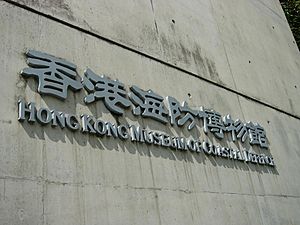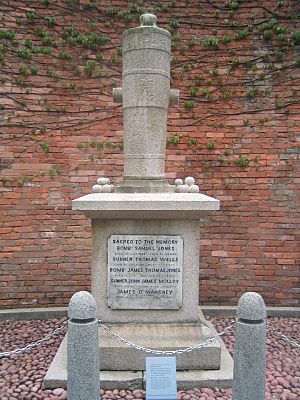Hong Kong Museum of Coastal Defence facts for kids
| 香港海防博物館 | |

Hong Kong Museum of Coastal Defence name relief.
|
|
| Location | 175 Tung Hei Road, Shau Kei Wan, Hong Kong |
|---|---|
| Type | Public |
| Owner | Government of Hong Kong |
| Hong Kong Museum of Coastal Defence | |||||||||||||
|---|---|---|---|---|---|---|---|---|---|---|---|---|---|
| Traditional Chinese | 香港海防博物館 | ||||||||||||
| Simplified Chinese | 香港海防博物馆 | ||||||||||||
|
|||||||||||||
The Hong Kong Museum of Coastal Defence is a cool public museum in Hong Kong. It's built inside an old fort that used to protect the coast. This fort looks out over the Lei Yue Mun channel, which is a narrow waterway near Shau Kei Wan on Hong Kong Island.
The British built this fort way back in 1887. Its main job was to guard the eastern entrance to Victoria Harbour. The museum covers a huge area, about 34,200 square meters. Inside, you can explore a permanent exhibition called "600 years of Coastal Defence." This exhibit tells the amazing story of how Hong Kong's coast has been defended throughout history. It starts from the time of the Ming dynasty, goes through the First Opium War and Second Opium War, and covers the Battle of Hong Kong during World War II, right up to today.
Contents
The Fort's History: Protecting Hong Kong
The Lei Yue Mun Fort has a long and important history. It played a big role in defending Hong Kong, especially during wartime.
World War II: The Battle of Hong Kong
On December 8, 1941, Japanese forces launched attacks on Hong Kong Island. After they took over the New Territories and Kowloon, the British soldiers made the defenses at Lei Yue Mun even stronger. They wanted to stop the Japanese from crossing the Lei Yue Mun Channel from Devil's Peak, Hong Kong.
The soldiers at the fort fought bravely. They managed to push back several Japanese attacks. However, they were eventually outnumbered and the fort fell to the enemy on December 19. After the war, the fort was no longer needed for defense. It became a training area for British soldiers until 1987, when it was finally left empty.
From Fort to Museum: A New Beginning
In 1993, the Urban Council decided to turn the old fort into a museum. After a lot of work, the museum officially opened its doors on July 25, 2000.
In September 2018, the museum had to close for repairs. This was because of a very strong storm called Super Typhoon Mangkhut. The museum reopened on November 24, 2022, after all the repairs and renovations were done. As of 2023, there are plans to change the museum into the Hong Kong Museum of the War of Resistance and Coastal Defence. This will focus even more on Hong Kong's role in that important conflict.
Exploring the Museum: What You'll See
The museum has three main parts for visitors to explore. These are the Reception area, the Redoubt, and the Historical Trail. The entire museum is built within the old Lei Yue Mun Fort, which is over a hundred years old!
Inside the Redoubt: Exhibition Galleries
The Redoubt was once the main military building of the fort. The old rooms inside, called casemates, have been turned into cool exhibition galleries. Here, you can see permanent displays that tell the story of Hong Kong's coastal defense.
- Ancient Times: Learn about defense during the Ming dynasty and Qing dynasty.
- British Rule: Discover how the British defended Hong Kong.
- Japanese Invasion: Understand the Battle of Hong Kong and its impact.
- Modern Day: See how defense changed after Hong Kong was returned to China.
Historical Military Structures: Walk Through History
As you explore the museum, you'll find many original military structures. These show you what the fort was like when it was active.
- Redoubt: This was built in 1887 and was the heart of the Lei Yue Mun Fort.
- Central Battery: Finished in March 1887, this battery held large guns. You can see a 7-inch (17.8 cm) gun barrel here, which weighs 4.5 tons!
- Western Battery: This battery, completed in March 1887, had two 9-inch (23 cm) guns. One of the gun barrels on display here weighs a massive 12 tons! It was found in 1990.
- The Torpedo Station: Built between 1892 and 1894, this station was carved right out of the rock. It was used for a special weapon called the Brennan Torpedo. This was the last torpedo station of its kind built by Britain or its overseas territories.
- Lei Yue Mun Pass Battery: This battery was finished in March 1892. It was built to protect the harbor from small, fast torpedo boats.
Getting There: How to Visit
It's easy to get to the museum! You can take the MTR to Shau Kei Wan station. From Exit B2, it's about a 15-minute walk to the museum.
See also
- British Forces Overseas Hong Kong
- List of museums in Hong Kong



